31 Marzo 2011
English
TRAVERTINE, AN ITALIAN STONE
Location and characteristics of the material*
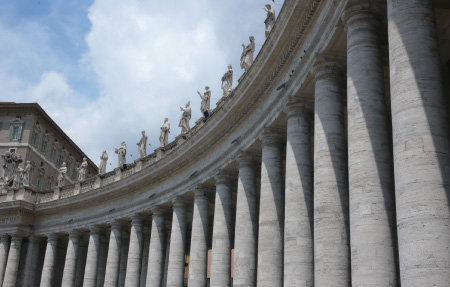
The colonnade of St. Peter’s Basilica (1659-67) in The Vatican City, by Gian Lorenzo Bernini. (ph. Alfonso Acocella)
This introduction aims to above all celebrate the richness and variety of lithologies in Italy. These emerge in the Alps and through the long Apennine chain to the Puglia Tableland, reappearing within the peculiar topography of the country’s major islands (Sicily and Sardinia). The different varieties have provided a wide array of building materials, characterising the urban and rural architecture of these areas:
“Even among the stones characterising the buildings in some cities”, states Francesco Rodolico in the book Le pietre delle città d’Italia, “the differences are such that they are noticed by even the most distracted of travellers: the compact limestones of Trento, Brescia, Assisi or Sulmona, the soft ones of Lecce or Noto; the travertine of Ascoli Piceno; the grey sandstone of Cortona or the yellowish one of Volterra; the gneiss of Bellinzona; the volcanic tuff of Viterbo; the Etnean lava at Randazzo. Nor are such striking differences noticeable between distant cities only; the above-mentioned geological differences are also found locally, differentiating nearby cities in this particular aspect».1
The traditional use of stone in architecture has decreased significantly, especially in the second half of the 20th century. This material now often serves merely ornamental purposes, used as thin slabs for wall cladding or floor paving. At a time when the focus is on careful promotion of national resources and territorial identity, the moment has come to study once again traditional heritage as well as technologically advanced methods of construction in the search for innovative applied solutions.
With few exceptions, every Italian region still has a significant patrimony of stone materials that – thanks to the new, more powerful technologies for transforming quarried raw materials – may be exploited within the context of contemporary architecture.
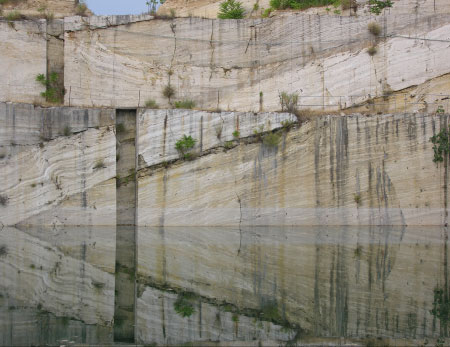
Sienese Travertine quarry at Serre di Rapolano. (ph. Alfonso Acocella)
[photogallery]ts_luoghi_album[/photogallery]
Nowadays, if one excludes prized materials such as marble (a category mainly used for ornamental cladding), there remains the large group of stones and that of granites (characterised by varied typologies and geographic distributions) for possible stereotomic uses, i.e. for structural purposes or at least strongly contributing to the formation of architectural envelopes. This is the case of stone materials from central and southern Italy in particular and include travertine, the object of our study. Besides being economic and easily cut into blocks or thick slabs, it is considerably resistant and aesthetically pleasing. The group of rocks classified as travertine comprises a fairly homogeneous category of lithotypes. Variations and internal differences are limited to colouring and sedimentary position.
One of the largest and most ancient travertine deposits is in Tivoli, near Rome. Travertine derives its name from this town, which was known as Tibur in ancient Roman times. The Latin name for this stone, “lapis tiburtinus”, meaning “Tibur stone”, was corrupted to travertine in the medieval period. The sites that provided the construction material for so many monumental buildings in Roman antiquity over a period spanning more than twenty centuries are still operative. They are concentrated in the municipalities of Tivoli and Guidonia-Montecelio, where there are some thirty quarries. The uninterrupted supply of material from these sites has almost completely erased the more ancient traces of excavation.
Barco and Fosse are the specific sites in which Roman travertine was quarried. Via Tiburtina divides the two areas. To the south, Barco (in the Municipality of Tivoli), from which most of the stone material used in Roman construction under the Caesars was derived, and to the north, Fosse (Municipality of Guidonia-Montecelio), where all the stone for the most important works of Papal Rome from the 16th century on, for example the monumental colonnade of St. Peter’s Basilica and the Spanish Steps, was quarried.
The vastness and size of these quarries give an idea of the importance of travertine. In the 1st century BC this lithotype became the “representative material” of Imperial architecture, supplanting the less resistant and durable stones (tuff, peperine, Gabine stone) used for centuries in the Republican period. Such impressive traces of quarrying activity through the centuries for the monumental buildings of Rome are highlighted by Giuseppe Cozzo: «The largest travertine quarry used by the Romans was that of the Barco, from which a very compact stone, hard to work, is extracted. Its enormous size sustains the hypothesis that it was if not the only, certainly the main quarry worked by the Romans. Senator Lanciani, who has had occasion to study it carefully, found that it was more than two and a half kilometres long between facing vertical walls. Its surface area reaches five hundred thousand square meters, and about five and a half million cubic meters of travertine have been quarried».2
The technical and aesthetic qualities of this stone are such that its use has always been suitable and gives striking results. Travertine is thus the architectonic material which characterises the city of Rome. First a symbol of the splendour of Imperial and Papal Rome and now, in a sense, of Italy in the world.
The industrial sector of Roman travertine preserves a certain prestige due to its longstanding tradition and the quality of workmanship. It currently comprises several dozen companies of medium to large size covering all aspects of travertine quarrying and processing for national and international markets, as well as small firms and artisan workshops.
Leaving the area of “lapis tiburtinus” and looking to the more general geology of Italy, the availability of travertine and its use was much more varied and widespread in the ages subsequent to Antiquity.
Giorgio Blanco, in his Dizionario dell’Architettura di Pietra (Dictionary of Stone Architecture), lists twenty-three different types of travertine quarried in Italy.3 The largest travertine deposits and most of these varieties are concentrated in just a few areas: along the river valleys of the Arno, the Tevere, the Aniene and the Sacco. The major national areas of extraction – besides the districts of Tivoli and Guidonia Montecelio in Lazio previously mentioned – are located in the areas of Ascoli Piceno in the Abruzzi and of Siena (in particular Rapolano Terme) in Tuscany.
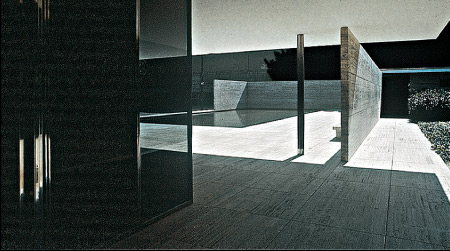
The German Pavilion by Ludwig Mies van der Rohe for the Barcelona Universal Exposition (1929/1983-86). (ph. Alfonso Acocella)
At Ascoli Piceno, travertine has been quarried for centuries and is the dominant material in the rich fabric of historical centres in the area. This lithotype is to this day present in reasonable quantities in the upper valley of the River Tronto, especially in the stretch between Ascoli and Acquasanta Terme, where the formation of deposits is linked to tectonic motion. Thermomineral waters are discharged from the deep fractures in the Acquasanta anticline; these waters are responsible for carbonate precipitation and the formation of travertine deposits. Thanks to its abundance, this silvery grey stone has always been the main material used to construct homes, buildings of importance and infrastructures. Between the medieval period and the Renaissance, it characterised most of the monumental buildings in Ascoli Piceno, giving the city a unique aspect that is largely intact to this day. Efforts are currently being made to revive and relaunch the travertine extraction and processing industry of Ascoli by widening its market from a local to a regional and national scale.4
In contrast to the still modest processing capacity of the district of Ascoli, that of Tuscany is growing. Although some historical stones in the territory of Siena – yellow Siena marble, the black marble of Murlo, macigno sandstone – are increasingly rare, there are still considerable banks of travertine, as described by Francesco Rodolico: «The hilltop of Siena (characterized by three converging crests, each corresponding to one “third” of the city) is part of a series of hills between the Arbia and Elsa valleys consisting of Pliocene marine formations that are sandy at the top and clayey at the bottom. In particular, the hill of Siena consists entirely of loose or consolidated yellowish sands called tufo, as are most of the hills that continue to the north and west; to the south and east, instead, the landscape is dominated by the whitish clays of the crete.
The Pliocene terrains, sometimes covered by Quaternary travertine deposits (especially in the areas of Colle Val d’Elsa and Rapolano), crop out between groups of Mesozoic hills, such as those of the Montagnola Senese, or Cenozoic ones, like the Chianti hills. This setting certainly favoured the predominance of bricks in the buildings and architecture of Siena, at the same time providing a wide variety and wealth of stones to the builders of one of Italy’s major art cities (…).
Here and there the Quaternary travertine (…), in horizontal layers of up to several tens of meters, covers the Pliocene terrains: a strip of more than fifty square kilometres lies near Colle Val d’Elsa. With only a few brief interruptions, another covers the Pliocene terrains from Asciano to the present-day springs of Rapolano. An 18th century naturalist commented, “one treads on a paving of Travertine and Spugnone [a porous limestone] for almost two miglia, there being travertine quarries along this stretch that are used for construction in Siena”. The quarry cuts often show the more recent spongy rock towards the top. The best types, though always porous or even cellular, lie towards the bottom. The hardness [of travertine] increases markedly after extraction from the quarry, so that it is opportune and easier to work the freshly quarried rock. This characteristic, along with its excellent mechanical resistance and negligible frost susceptibility, explain the widespread diffusion of Sienese travertine to this day. The colour of the stone, which is often pleasantly striated, varies from white to yellowish; it is rarely brownish».5
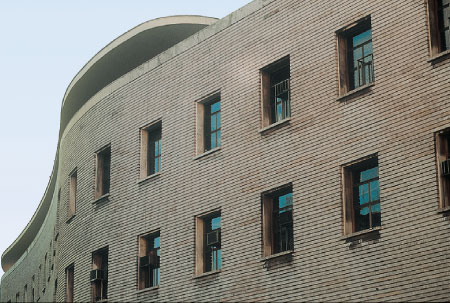
Palazzo delle Poste (1933-36) in Rome, by Mario Ridolfi. Facade clad with “strips” of Tuscan travertine. (ph. Alfonso Acocella)
Within this book, the exhaustive essay by Davide Turrini on the quarrying and processing district of Siena provides data and tangible evidence of historic and current activity undertaken by the Consorzio del Travertino di Rapolano. Along with the Regione Toscana, this consortium has sustained research on the territory and the publication of this volume. For further information the reader can refer to this essay – and to that by Anna Maria Ferrari regarding travertine and its genesis.6
On travertine: the essence of the material
This lithotype may be considered a concretionary rock with a microcrystalline structure (formed through sedimentation near thermal waters, lakes, springs and waterfalls). It comprises different carbonate lithologies of chemical or biochemical origin: when the calcium bicarbonate dissolved in water precipitates, it forms calcium carbonate deposits that encrust objects of mainly plant origin. In other words, the formation of travertine is linked to the upwelling of thermomineral waters particularly rich in calcium carbonate that spring from the surface of the earth. Its genesis, due to a continuous and progressive accumulation of carbonate material from the zones of dissolution to those of precipitation, has led to the sedimentation of these rocks in parallel, horizontal layers sometimes characterised by marked variations in colour and widespread porosity.
Note that, from a mineralogical standpoint, calcium carbonate (in the form of calcite) represents the main component of travertine (generally more than 95%). The accessory elements include some clay minerals, quartz, iron and manganese oxides and hydroxides, sulphur, gypsum, white mica and chlorites.
The fossil moulds of vegetation give the material specific morphogenetic characteristics. During sedimentation, vegetation (e.g. stems, leaves, algae, twigs) is incorporated within the forming calcareous concretion; its subsequent decomposition produces numerous characteristic “incisions”, “wounds” and cavities, sometimes of centimetric size, in the stone material.
Often striated, with its evident gaps and irregular pores, travertine invites us to decipher its formation history from the cut surface, to investigate the materials that were incorporated in its geological past. Vegetation or, more rarely, small organisms such as tiny terrestrial invertebrates or freshwater molluscs are returned to us in “latent” form when the rock is quarried or when it is mechanically cut in a factory.
The volumetric proportion of voids varies significantly from one deposit to another, as well as from one layer to another within the same rock bank. Due to this percent variation in pore volume the density of travertine varies from 2300 to 2700 Kg/m3. The quantity of pores generally ranges widely from 2 to 45% of the total rock volume. The less compact varieties, characterised by numerous macroscopic cavities, are commonly known as “sponge stones” or “calcareous tufa”; pores normally make up more than 20% of the total rock volume.
Notwithstanding its porosity, travertine has low frost susceptibility, and good mechanical resistance and durability that make it particularly suited for construction.
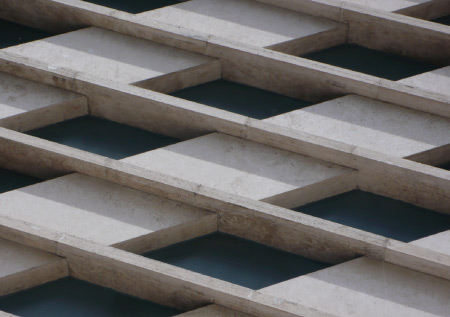
Palazzo delle Poste (1933-36) in via Marmorata in Rome, by Adalberto Libera. Facade detail showing the travertine cladding. (ph. Alfonso Acocella)
Marco Giamello explains the essential role played by the porosity of the material: «In particular, the porous structure common to all stone materials varies widely, even in materials with a similar mineralogical composition and consisting mainly of calcite (for example carbonate rocks, travertine, other limestones and marbles). For a given total porosity, defined as the percentage of pore volume with respect to the total volume, it is possible to have structures with different pore distributions as a function of pore diameter. The size of pores is important in favouring the capillary absorption of water and the initiation of processes that lead to the physical-chemical degradation of the stone.
In contrast to other lithotypes such as marble and sandstone, travertine has a high porosity mostly determined by the presence of macropores, i.e. pores of considerable size. Within this macroporosity, new crystals formed by precipitation of soluble salts and ice crystals have enough room to grow without putting pressure on the pore walls. Weathering processes linked to an increase in volume are thus annulled, and the formation of carbonate encrustations on the surface is limited. Thanks to this peculiarity, travertine has good durability, defined as the resistance to alteration in time».7
With respect to foreign travertine, characterized by particular, often vivid colours, Italian travertine forms a group of lithotypes with varied textural patterns but a rather “homogeneous” colour palette which ranges from light tonalities – such as white, silver, beige and hazelnut – to golden yellow, pinkish and brown.
Through exposure to air and the passage of time the lighter coloured travertine develops an “outer skin”, i.e. a characteristic soft, yellowish patina due to the oxidation of iron salts in the stone. In particular, pyrite crystals scattered within the rock mass are transformed into limonite, which gives the stone a “blonde colour” typical of Roman travertine especially.
The warm, homogeneous colour of the material, along with its vibrant surface under variable exposure to light (which interacts with the texture of pores), is such that travertine is greatly appreciated for its uniqueness. Along with this quality, historically the stone has been primarily valued as a massive, resistant building material which lends itself to be both shaped by the stoneworker (or sculptor) and moulded by the architect.
The high durability and mechanical resistance (with a tensile strength of up to 120 MPa), along with the workability of the material, have helped affirm the use of travertine in Italian and international architecture, well beyond the limited territories in which it is quarried. In particular, the relative ease with which it is worked and sculpted is due to the significant amount of water in the freshly quarried rock mass which makes it “docile” to utensils and all kinds of processing. As travertine dries it “changes state”: the progressive loss of water increases its solidity and hardness – parameters that in time reach very high values.
In the last decades the structure of the Italian working of travertine – traditionally characterized by artisan quarrying and processing and mostly focusing on the production of solid elements (masonry blocks and ashlar, sill courses, cornices, columns, slabs for facing, sculptures, products of urban design, etc.) – has been profoundly modified to produce more industrial items in series, thereby losing many of its traditional characteristics.
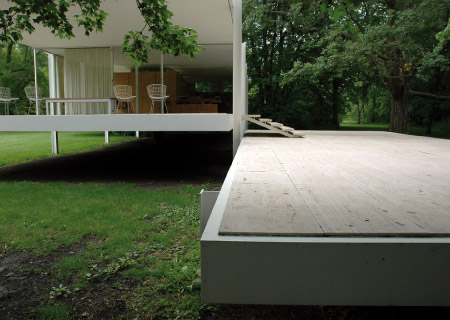
Farnsworth House (1945-51) in Plano, by Ludwig Mies van der Rohe. Corner detail of the deck paved in travertine.
As a result, even travertine – historically appreciated for its compact, solid nature and for its economic use in massive slabs – has been relegated to a “narrow” and “simplified” existence through its homologation in the modern serial and standardized production cycle. Typical products are the regular quarry blocks and the slabs that are stacked in great number and in precise order in the yards of companies while waiting to be used in increasingly standardized mass housing projects which do not make the most of the actual qualities of materials.
The use of travertine as a resistant, plastic material able to confer solidity, volume and weight to architecture, through smooth or modelled wall facades, “rough” or ashlar surfaces with great chiaroscuro expressive value, has been assigned secondary importance. Its typical use in construction can be traced in the “travertine cities” – from those of the classical period, such as Rome or Perugia, to the medieval centres of Siena, Rieti, Ascoli Piceno, Ancona, etc. Architects should return to these cities to observe and fully understand this material and absorb its markedly plastic, solid, rich personality.
In other words, we would like to take advantage of this volume on Sienese Travertine to once again indicate the many possible uses of this building material, not only as thin slabs for lining, externally or externally, wall surfaces and pavements.
Its continuous use recorded in some Italian cities no doubt makes it a material typical of Italian tradition; however, there are numerous examples of its international diffusion. In contemporary architecture – thanks to the aura derived from it having been the material of Roman magnificence – the use of travertine is toned down in the refined and essential forms of Modernism found in works by Adalberto Libera, Mario Ridolfi, Mies van der Rohe, Louis Kahn, Carlo Scarpa and – more recently – in the architectural design of Alberto Campo Baeza, Richard Meier, Renzo Piano, Rem Koolhaas, David Chipperfield, Ortner & Ortner, 3N Architects, Mansilla + Tuñón Arquitectos (to name only a few protagonists of the international scene); these works have been critically discussed in the essay by Luigi Alini, to which the reader can refer for further details.
Notes:
1 Francesco Rodolico, “Introduzione” p. 20, in Le pietre delle città d’Italia, Firenze Le Monnier, 1965 (ed. or. 1953), pp. 500.
2 Giuseppe Cozzo, “Marmi e pietre” p. 53 in Ingegneria romana, Roma, Multigrafica Editrice, 1970 (ed. or. 1928), pp. 317. For a discussion on the use of travertine in Imperial Roman architecture see: Giuseppe Lugli, “Lapis Tiburtinus (travertino)” pp. 319-333 in La tecnica edilizia dei romani, Rome, Bardi, 1988 (ed.or. 1957), pp. 741.
For its use in the modern and contemporary period see: Enrico Clerici, “Il travertino di Fiano Romano”, Bollettino del Regio Comitato Geologico nn. 3-4, 1887, pp. 2-27; Giuliano Bellezza, L’industria del travertino romano nella prospettiva geografica, Roma, Ferri, 1973, pp. 47; Il travertino romano di Tivoli, Rome, ANIS, 1984, pp. 119; Luciana Rattazzi (edited by), Sulla pietra di Roma, Rome, Edizioni Kappa, 1995, pp. 120; Silvano Olezzante, Gli uomini del travertino: l’attività estrattiva nell’area di Guidonia e di Tivoli, Rome, Ediesse, 1998, pp. 78.
3 Giorgio Blanco lists the following types of travertine: Travertino Ascolano (Ascoli Piceno), Travertino Bianco Spugnoso di Siena (Asciano, SI), Travertino della Selva (Poggio Moiano, RI), Travertino della Valpantena (Grezzana, VR), Travertino di Alcamo (Alcamo, TP), Travertino di Angera (Angera, VA), Travertino di Bagni di Lucca (Bagni di Lucca, LU), Travertino di Jano (Jano di Montaione, FI), Travertino di Latina (Fondi, LT), Travertino di Monsummano (Monsummano Terme, PT), Travertino di Orte (Orte, VT), Travertino di San Casciano Bagni (San Casciano Bagni, SI), Travertino Doré (Tivoli, RM), Travertino Ligure (Orco Feligno, SV), Travertino Maschio di Monte Nerone (Piobbico, PS), Travertino Montemarano (Montemarano, GR), Travertino oniciato di Poggio Moiano (Poggio Moiano, RI), Travertino romano (Tivoli, Guidonia-Montecelio, RM), Travertino Sabino (Poggio Moiano, RI), Travertino spugnoso colorato di Castiglione d’Orcia (Castiglione d’Orcia, SI), Travertino toscano (Rapolano, SI).
Giorgio Blanco, “Travertino” pp. 218-221 in Dizionario dell’Architettura di pietra, Rome, Carocci, 1999, pp. 299.
4 For the travertine from Ascoli Piceno see: Alessandro Martelli, “Note geologiche e paleontologiche sul Travertino di Ascoli Piceno”, Rivista Italiana di Paleontologia n. 2, 1908, pp. 97-102; Giovanni Poli, Il travertino, la pietra nobile ascolana, Ascoli Piceno, STE, 1952, pp. 46; Roberto Colacicchi, Carlo Boni (edited by), Indagine geologica sui travertini della provincia di Ascoli Piceno, Ascoli Piceno, C.C.I.A.A., 1966, pp. 88; Giannino Gagliardi, Carlo Melloni, Carlo Paci, Ascoli Piceno: nel colore del suo travertino il calore di una città, Ascoli Piceno, APT, 1993, pp. 42; Travertino ascolano: storia, arte, artigianato, catalogo del concorso nazionale per opere di scultura e di arredo urbano o sacro, Acquaviva Picena, Fast Edit, 1998, pp. 67; Francesco Quinterio, Ianua Picena: materia e linguaggio nei fronti degli edifici di Ascoli, dal periodo preimperiale al Novecento, Ascoli Piceno, Istituto Cecco d’Ascoli, 2004, pp. 183; Pippo Ciorra and Stefano Papetti (edited by), Ascoli città di travertino, in press.
5 Francesco Rodolico, “Siena” p. 287, in Le pietre delle città d’Italia, Florence Le Monnier, 1965 (ed. or. 1953), pp. 500.
6 For a focused discussion of Tuscan travertine from Rapolano see: Cristina Piersimoni (edited by), Le pietre di Rapolano, Siena, Grafica Pistolesi, 1995, pp. 63; Consorzio Siena Export, Il travertino di Siena, Siena, Al. Sa. Ba., Grafiche, s.d., pp. 95.
7 Marco Giammello, “Impieghi nell’architettura senese e tipologie di alterazioni del travertino”, p. 55, in Cristina Piersimoni (edited by), Le pietre di Rapolano, Siena, Grafica Pistolesi, 1995, pp. 63.
*This essay is part of the book edited by Alfonso Acocella, Davide Turrini, Sienese travertine, Firenze, Alinea, 2010, pp. 303.
